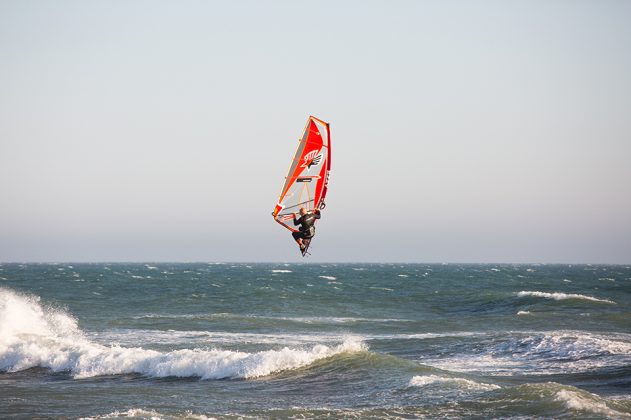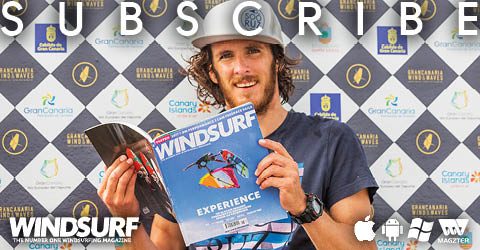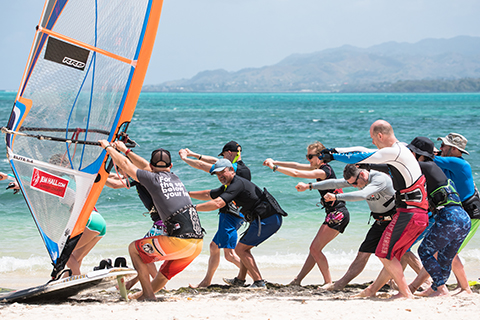
‘Helping yourself to understand what position you should be in is very powerful.’
PHOTO Nicolas Jones
FITNESS
Our sport is very physical so this is hugely important. You may well be an early planing Jedi but without lower leg flexibility and strength you simply will not learn the waterstart. Without a strong core, legs and triceps you cannot pin the board to the water when well powered.
Wavesailing is indeed another notch up in physical demands. I urge you to work on your sailing fitness through shorter reaches, attempting more (and different) moves and sailing more unhooked. I also encourage you to get fitter, in strength, flexibility, core stability and cardio. Some tips from me are to do compound (multi joint) body weight movements like squats, press-ups, and chin-ups. In your cardio, some long duration activity can help, but in the main look at interval (work and recovery) training. Learn all this, do it and be in a position to attack both your fitness AND water sessions. Barney from Ireland trained hard for his first clinic with me and lost 5 kilos, his focus in this area also helped him focus on the water too!
VISUALISATION
This can take many forms. One example can be where you watch (live or on playback) a respected rider complete a move and then look to understand what they are doing, where, how and when, then you play this ‘clip’ in your mind and slowly put yourself as the rider in the clip. The more you effectively think about your windsurfing targets and moves the more you will actually improve subconsciously, this will see you move from ‘a passenger to a pilot’ on the water. A Turkish ripper, called Teo, did not sail for 3 months between coaching clinics (over winter) but whilst at home just watched videos and read articles between trips and improved astonishingly, it was like watching a different person windsurf!
TUNING
Understand your gear and set it up in the right way when you are at home and not in the heat of battle. This might be rigging your sails up with the help of tuning videos, or it could be changing your footstrap setup so it is ready for your next session. Many of my students contact me for tips on how to set their boards up and then report back how this works out, so I also learn from their feedback.
CROSS TRAINING
Other surf sports can help your windsurfing. For example, learning and improving in SUP has been hugely beneficial for me, and others, to improve in the areas of balance, water confidence and learning to work with the waves. In my experience many windsurfers do not actually have good balance as they can continually grab and pull on the boom! A tall chap called Mike, who resides on Ireland’s west coast, picked up the unfortunate nickname of ‘lamp post’ and so he now works hard whilst both surfing and SUP’ing to ‘get down James Brown’ to help in his windsurfing and other surf sports!
GAME ON – AT THE BEACH AND DURING YOUR SESSION
ASSESSMENT
You have arrived at the beach and as a ‘pilot’ look to ask yourself these questions:
• What are the conditions doing?
• What are my opportunities to improve? If it is marginal and flat you can maybe work on your tacking for example.
• What therefore are my targets? Be specific, set some numbers, set a time frame, like 10 loop attempts in 30 minutes.
• What gear do I NEED to use to meet these targets? Note that NEED is very different to WANT here. To improve tacking you need a bigger board!
Set your targets and then after a few minutes (runs in and out) consider are these the right targets or should I change them? Or perhaps change my gear or my tuning? I can tell when one of my students is focussed on improving when they ask me for their own individual targets and then follow through and do as I suggest!
HOW I IMPROVED
I learnt windsurfing on the coast in Portsmouth, UK, at 14 years old. I got my own kit and a trolley, and would meet my friends down the beach after school and at weekends. We just sailed and sailed and stayed out for a long time in all winds, this is where I realised the power of flow and keeping moving on the water and trying as many tacks and gybes as possible. Also in these teenage years we did lots of light wind sailing on beginner boards with small sails from our local shop and I feel this is where I really benefitted from doing sail tricks and many hours out of the harness.
Fast forward a few years and after graduating Uni I went on a long trip to Western Australia and here this extended period of focussed sailing really made me understand the power of ‘immersion,’ which is where you totally dedicate your time to a skill with few distractions. I also really improved my ability to watch people do moves, break them down and then go out and try them and work hard to nail them.
After this I then did many seasons teaching windsurfing in overseas centres and this was hugely beneficial for 2 reasons; I now had peers to discuss with how best to learn a move and put the key points across, and I had a ‘buddy’ to learn key moves like the forward loop with. If my friend Lee and I had not attacked the forward together I doubt I would have got it so quickly.
As an aside I also understood the benefit of an ‘hour of power’ during my seasons, as this was what we had each day during our time off and so we hit the water fully pumped and ready to hit our targets!
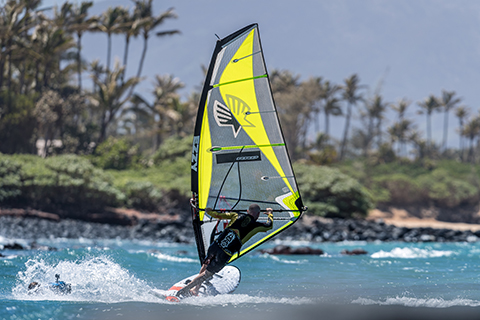
‘Visualising the mid part of the step gybe really helped me nail this move 20 years ago, and be in a position to continue to refine it.’
PHOTO Dave White
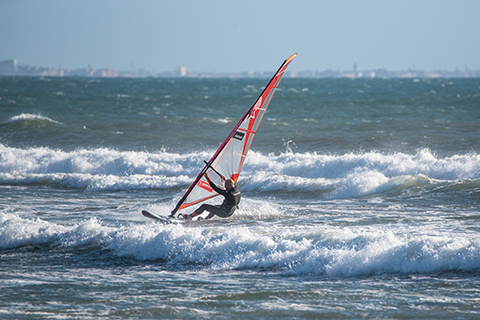
‘Practicing the tack many many times in easy conditions with a positive self dialogue will up your success considerably in wavier sessions.’
PHOTO Nicolas Jones
LOCATION, LOCATION, LOCATION
We are now on to some more questions and further refining our session strategy:
• What is the best part of this location to hit my targets? This might be upwind or downwind, inside or further out.
• Is this the right location for me to improve at my level? This is also relevant when planning where to sail, your closest spot may not be the best for you to improve. 4 hours bump and jump is not as good for your wavesailing as 1 hour of wave time if that is your focus.
FOCUS, BELIEVE AND ENJOY
This is one of my main mantras for coaching and it really helps both my people and I improve. Focus – means know what you are about to do, how and where. Believe – means that throughout your session you have that previously mentioned positive self-dialogue and that you take the rough with the smooth, i.e. don’t get too down if you make mistakes, and focus on the positives of your session. Enjoy – our sport is a lot of fun and we can sometimes forget that to our detriment while trying hard to improve, so get a smile on and share your stoke with other windies too. It helps contribute to a positive learning experience and keeps you motivated.
One of my biggest tips is to not ‘oversail’. For me this is an hour of power, after this my mental fitness and focus drops, I sail slower and start dropping moves. If you ‘oversail’ and your skills begin to deteriorate then you are in fact ‘practicing your mistakes.’ Next tip is to work on your key targets early in the session and not for longer than 20 minutes, this is highly relevant for waterstarts and forward loops for example. I may do 3 hours of power in a day so yes you can still get your fix! I look to make all these hours effective and if my session is not going well I will cut it short. It is also important not to ‘undersail’ i.e. stop in shallow water after a couple of runs, this loses flow and makes you think too much, and not feel. I call this ‘strokey strokey, shuffle shuffle’ as this is when you fiddle with your boom (pretending to tune) and then shuffle upwind a few metres. Keep sailing and maintain momentum!
REFRESH
Come in after your hour of power to rehydrate, and maybe have a snack. This will give your brain some hugely valuable time to ‘download’ your session and allow you time to self coach, either consciously or sub consciously. This time out also gives you a chance to reset some new targets or just get more specific on your existing ones. One of my people in Jeri recently was ‘oversailing’ and I kept suggesting he was doing this and in the end he got huge holes in his hands and eventually could not sail; lots of short / medium sessions are better for both improving and your health.
POST-SESSION
Again, this can also be over a variety of time frames from hours to days and even months.
REFLECT
Make some notes at the beach on your phone or in a notebook about what gear you used, what you learnt and what tuning you need to do. Some questions for self-coaching might be:
• What did I do?
• What did I do well?
• What will I do next time?
• What feelings and key positions did I experience that felt right?
REFRESH
If you are fortunate to be sailing over many days, perhaps after work in the summer or on a trip, then you might want to help your muscles out by giving them a flush out with some light cardio the following day prior to getting in the water. You may even want to stretch key muscle groups like lower calf, hamstrings, forearms and back after your session as this is when you are motivated. This stretching time can also be valuable for reviewing your session before your brain gets clogged with all the other noise in your life. A long time ago one of my students had a real challenge with bending his arms too much so every morning he went for a walk before sailing with his arms extended in front of him – cardio detox and visualization, now that is multi tasking!
SELF-COACH
In this techy world we are now in we can utilise POV cameras with all manner of attachments to capture what we are doing. You may even have some pics of your sailing session from a chum or local photographer. Perhaps you have taken the step to book a coaching holiday and have a video debrief after your session. All of these help you to better self-coach and identify what it is you need to do nail a move, for example, looking to straighten your (bent) front arm when leading into your carve gybes. After I posted an article on how to use a POV camera to self-coach, West Witts sailor Andy went out with his mast mount camera and was sure he was looking forward in and out of his tacks and really moving his head when waveriding but the footage did not show this, so he used it as a spur to really work on his vision when sailing.
RRD boards, wetsuits & softwear, Ezzy Sails & Black Project fins sponsor Jem Hall. Get him live and direct on one of his highly acclaimed coaching holidays but be quick as they are selling out – check out his fab new site www.jemhall.com for details. You can also follow him on twitter / Facebook / Instagram.

